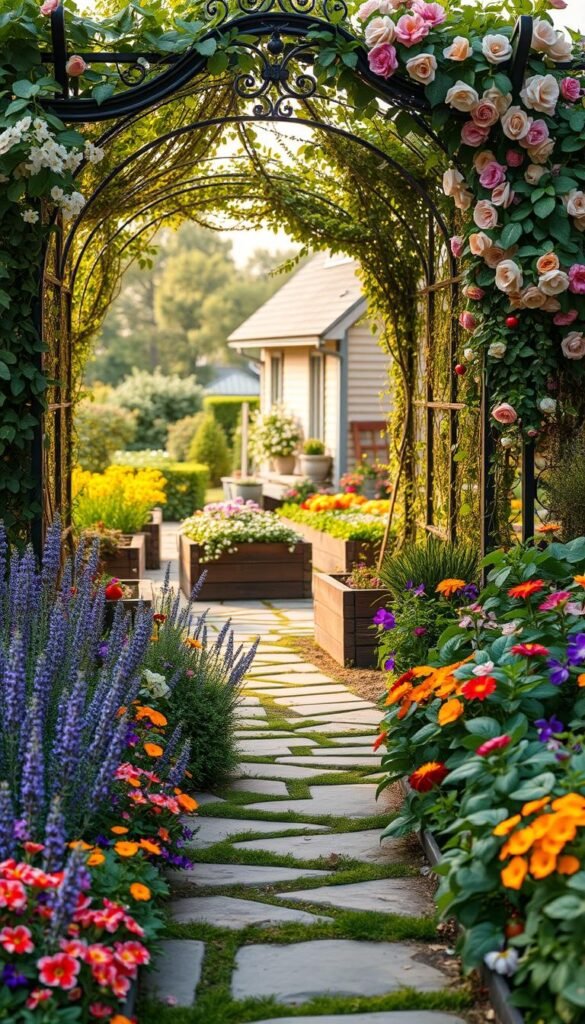Imagine stepping into an outdoor oasis where vibrant blooms brush against juicy tomatoes, and fragrant herbs nestle between colorful perennials. This style of plant arrangement transforms ordinary spaces into living tapestries that delight the senses while putting fresh food on your table.
Gone are the days when veggies grew hidden behind fences. Today’s gardening enthusiasts celebrate edible varieties as decorative stars. Picture ruby-red strawberries spilling over borders or feathery carrot tops adding texture to flower beds. These combinations prove functionality and charm aren’t mutually exclusive.
Whether you have acres or a compact patio, this approach adapts effortlessly. You’ll enjoy nonstop color and harvests from early spring to late fall. Curated plant pairings create depth and movement, ensuring something always catches your eye—or your pruning shears.
This method reimagines traditional layouts by letting practical plants share the spotlight with showstoppers like roses and peonies. The result? A personalized retreat that feels both abundant and intentional—a true extension of your home.
Welcome to Your Charming Cottage Vegetable Garden
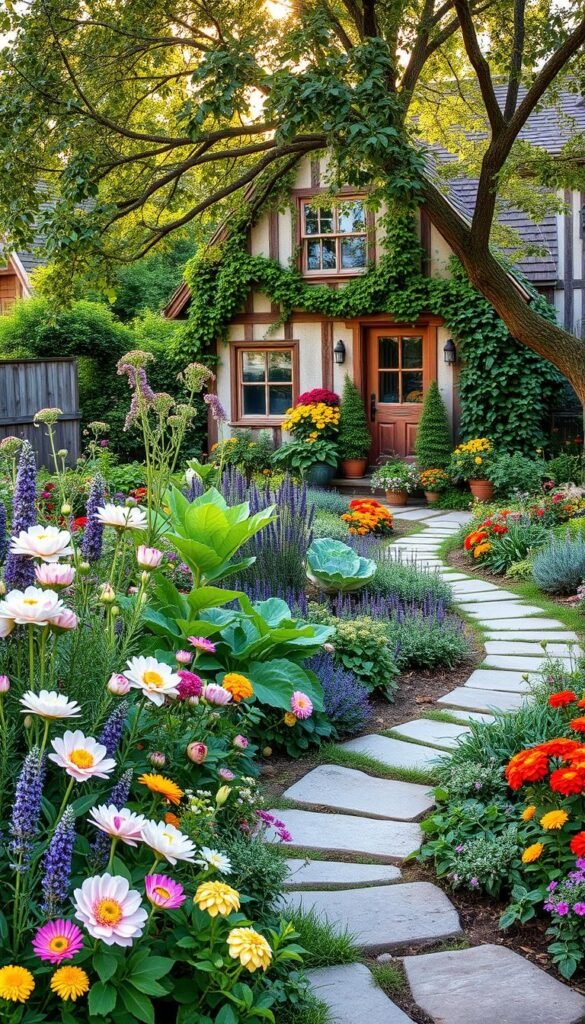
Consider a design where every plant serves dual purposes – delighting the eye while stocking your kitchen. This approach weaves practicality into beauty, creating living art that nourishes both body and soul.
Embracing the Cottage Garden Aesthetic
Traditional English plots blended herbs, vegetables, and ornamentals not just for looks, but survival. Today’s version keeps that free-spirited charm while adding modern flair. Think feathery dill swaying beside snapdragons or kale’s ruffled leaves contrasting with velvety pansies.
Why Mix Flowers and Edibles?
Blooming companions do more than dazzle – they’re garden superheroes. Marigolds repel nematodes near tomatoes, while lavender confuses pests hunting your basil. For thriving companion plant pairings, match sun needs and growth habits.
Edible stars like rainbow chard or purple bush beans bring their own drama. You’ll maximize space without sacrificing style, creating layers that bloom and fruit in harmony all season.
Planning Your Garden: A How-To Approach
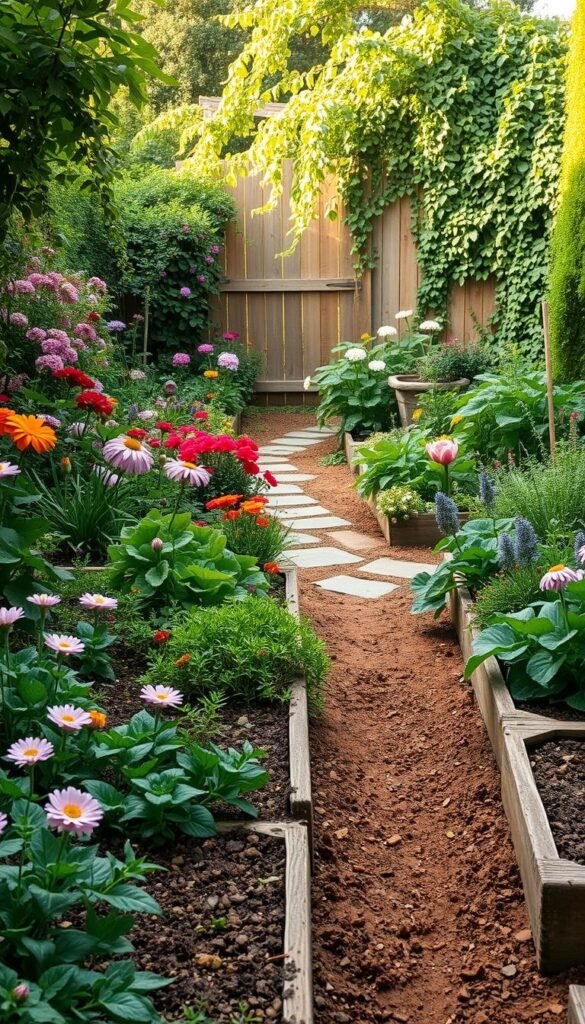
Transform your outdoor area into a thriving paradise by first understanding its unique characteristics. Smart preparation prevents overcrowding and ensures every plant thrives in its ideal conditions.
Evaluating Your Garden Space and Season
Begin by mapping your available space. Note how sunlight dances across the area—most edibles crave 6+ hours of direct exposure, while shade-tolerant herbs like mint flourish in dappled light.
| Factor | Key Considerations | Tools Needed |
|---|---|---|
| Sunlight | Track patterns using a sun calculator app | Smartphone, notebook |
| Soil | Test pH levels with kit from local nursery | Testing strips, trowel |
| Space | Measure mature plant size | Tape measure, graph paper |
Setting Your Garden Goals and Layout
Ask yourself: “Do I want a salad bowl at my doorstep or a floral masterpiece?” Create zones for moisture-loving lettuces and drought-resistant lavender.
“Good design marries beauty with purpose,”
says veteran horticulturist Marie Carter.
Sketch multiple layout ideas before planting. Cluster tomatoes with basil (they share water needs) but keep aggressive mint in containers. This way, you’ll enjoy fresh harvests from spring’s first sprouts through autumn’s final yield.
Essential Techniques for Successful Planting
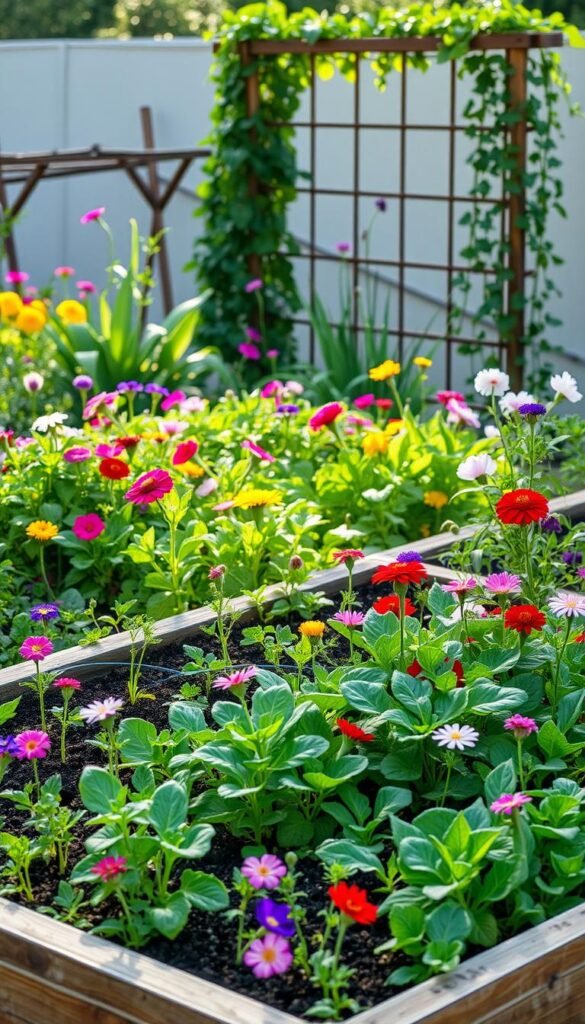
Annuals bring rapid color while perennials build depth—learn to harness both for garden success. These two plant types work like seasonal collaborators, offering instant vibrancy and enduring structure. Your choices here shape not just this year’s harvest but your landscape’s future personality.
Planting with Annuals: Quick Growth and Flexibility
These fast-paced plants let you reinvent your beds yearly. Basil and marigolds explode with life in weeks, filling gaps between slower growers. Mix zinnias with edible calendula for pops of orange that attract pollinators while repelling pests.
Sunflowers and snapdragons create vertical drama, their seeds ripe for saving. You’ll love how nasturtium leaves spice salads while their blooms cascade over borders. Rotate these stars each season to refresh your palette and soil health.
Nurturing Perennials: Long-Lasting Beauty and Texture
Rosemary and thyme form woody skeletons that survive winter, becoming fuller each year. Though sparse initially, these herbs develop into fragrant hedges by their third summer. Sage’s velvet leaves contrast beautifully with feathery cosmos in adjacent annual plots.
Over time, oregano spreads like living mulch, suppressing weeds naturally. For a seamless blend of ornamental edibles, explore three creative approaches that balance form and function. Your patience pays off as these beds become self-renewing ecosystems.
Cottage Vegetable Garden: Mixing Flowers and Edibles for a Romantic Look
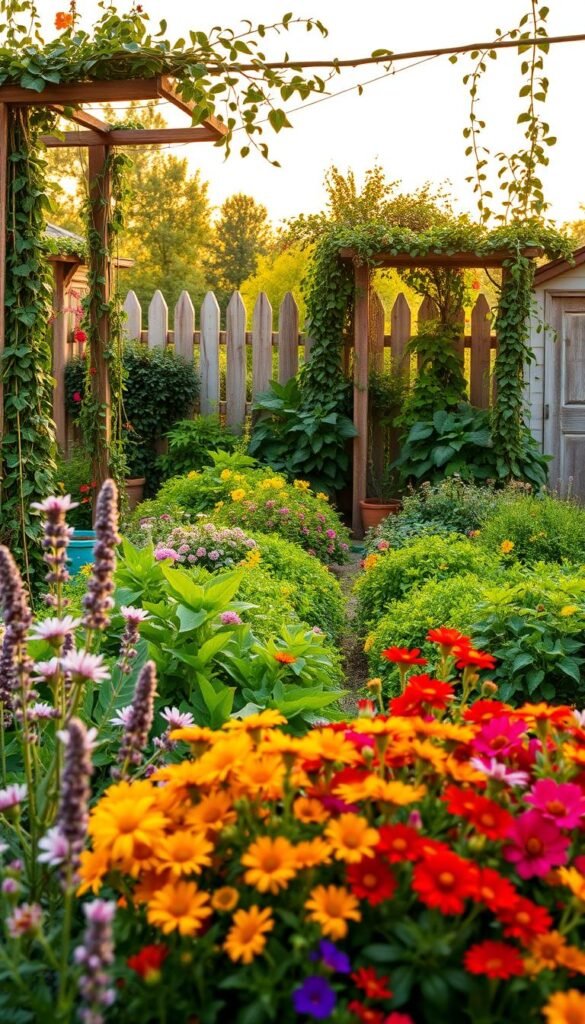
Create a vibrant tapestry of textures and hues by interweaving edible and ornamental species. Thoughtful arrangements turn functional plants into design elements, where ruby chard stems pop against pastel cosmos and thyme spills over walkways like living confetti.
Combining Herbs, Vegetables, and Flowers for Visual Appeal
Layer your garden like a floral lasagna. Place sunflowers or pole beans as backdrops, then mid-height basil and zinnias, finishing with creeping nasturtiums. This vertical stacking ensures every plant shines while conserving space.
| Tall Layer | Mid Layer | Ground Cover |
|---|---|---|
| Sunflowers | Purple basil | Nasturtiums |
| Tomatoes | Rainbow chard | Marigolds |
| Corn | Borage | Creeping thyme |
Pair silver sage with violet petunias for cool tones, or let golden marigolds echo yellow pear tomatoes. These combinations create photo-ready scenes that evolve weekly as different flowers and edibles take center stage.
Expert Tips for Companion Planting and Maintenance
Boost productivity through smart partnerships. Basil improves tomato flavor while repelling flies, and marigolds’ roots secrete pest-deterring compounds. Cluster moisture-loving lettuces together, but keep mint contained to prevent takeover.
| Companion Pair | Benefit | Maintenance Tip |
|---|---|---|
| Tomato + Basil | Enhanced flavor | Water deeply 2x/week |
| Cucumber + Nasturtium | Aphid trap crop | Trim spent blooms |
| Carrots + Chives | Pest confusion | Thin seedlings early |
Let some herbs like dill self-seed for that casual cottage charm. Time harvests around bloom cycles—pick zucchini before their flowers fade, ensuring both food and beauty stay abundant.
Innovative Designs: From Raised Beds to Containers
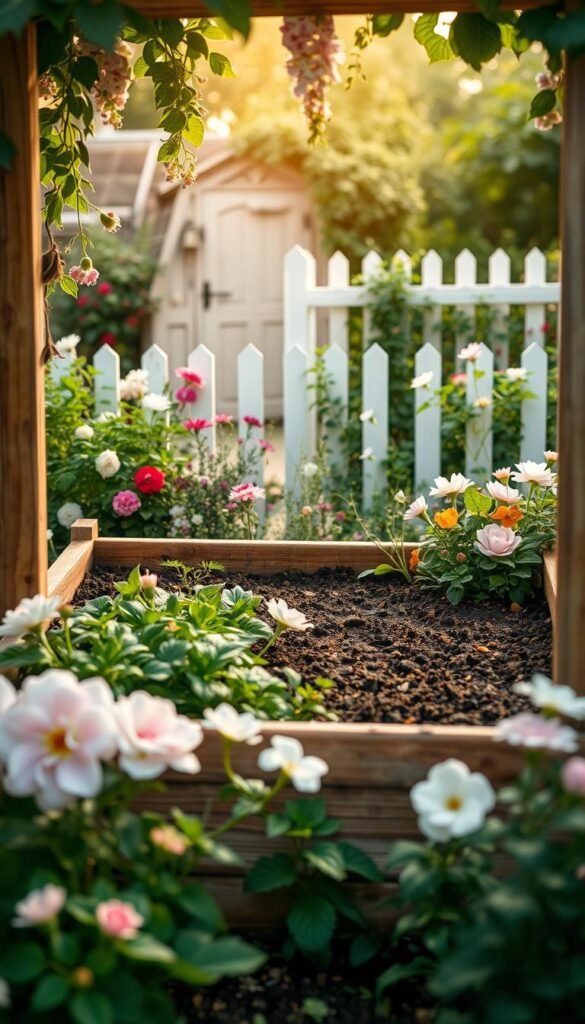
Redefine your outdoor space with smart designs that blend form and function. Whether working with sprawling yards or cozy balconies, creative layouts turn limitations into opportunities for lush growth.
Raised Beds and Edible Ornamentals
Elevated garden beds solve drainage issues while adding structure to your landscape. Triangular stone designs create focal points where tomatoes tower over basil, and marigolds frame strawberry clusters. This setup lets you control soil quality while preventing invasive roots from spreading.
| Vertical Layer | Suggested Plants | Key Benefit |
|---|---|---|
| Center/Back | Tomatoes, sunflowers | Height & structure |
| Middle Ring | Basil, peppers | Continuous harvest |
| Edges | Nasturtiums, thyme | Ground coverage |
Mix edible and ornamental varieties for textural contrast. Purple basil makes a striking companion to golden marigolds, while trailing verbena softens stone edges. Your space becomes both pantry and art gallery.
Container Gardening: Maximizing Small Spaces
Transform patios into productive plots using the thriller-filler-spiller formula. A cherry tomato plant (thriller) pairs with basil (filler) and creeping strawberries (spiller) for instant curb appeal. Group containers by water needs to simplify care.
| Theme | Thriller | Filler | Spiller |
|---|---|---|---|
| Pizza Garden | Tomato | Oregano | Thyme |
| Salad Bowl | Dwarf kale | Chives | Nasturtium |
Rotate pots seasonally to chase sunlight. Compact veggies like bush beans thrive in 12-inch planters, proving you don’t need acreage for fresh flavors. Your mobility becomes your garden’s superpower.
Final Touches for Your Garden Romance
Let your landscape become a living recipe where beauty feeds practicality. Allow annuals like calendula or dill to drop seeds freely between perennials—their spontaneous growth adds whimsy while reducing replanting efforts. You’ll discover new foliage patterns each spring, as nature’s surprises enhance your design.
Add finishing elements that delight the senses. Wind chimes near aromatic herbs create soundscapes, while mosaic stepping stones through vegetables blend art with function. Cluster containers of trailing strawberries and petunias near seating areas—you’ll snack and sip your morning coffee surrounded by blooms.
Maintain balance by editing overcrowded areas. Trim aggressive mint but leave some parsley flowers to attract pollinators. As tomatoes ripen, tuck fresh basil nearby for instant caprese salads. Your garden now tells a story where every leaf and petal contributes to your home’s charm.
This approach evolves yearly, growing richer like a well-loved recipe. Whether harvesting sun-warmed peppers or arranging zinnias for the kitchen table, you’ve created more than a plot—it’s a sanctuary that nourishes body and soul.
